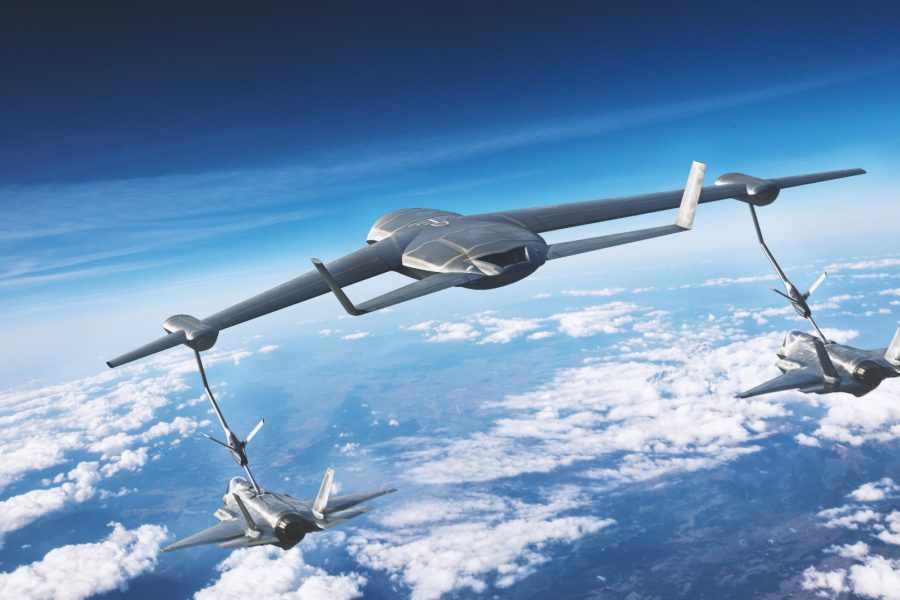An artist’s rendering of a Lockheed Martin Skunk Works concept for a potential stealthy and autonomous Next-Generation Aerial-refueling System (NGAS) aircraft is getting new attention after a repeat display at the recent Airlift/Tanker Association meeting.
The concept breaks with many other notional futuristic tanker designs which have been variations on a crewed flying wing or blended wing body. The Skunk Works artwork shows an uncrewed aircraft with a conventional planform, shaped for some degree of stealth.
The image, displayed at the A/TA’s conference last week in Grapevine, Texas, reveals a highly flattened design with Air Force-style refueling booms deployed from pods on the far outboard of the wings. Two outward-canted stabilizers at the tips of the elevators sit well apart from a central, sawtooth exhaust, but out of the way of the two refueling stations. The exhaust suggests a single engine, but the angle of the depiction does not reveal where the air intakes are, or their shaping.
Another image of the same concept published by The War Zone also conceals the intake shaping. The image shown at A/TA was first published by Aviation Week.
It’s not clear whether the flying booms used to connect to receiver aircraft could be made stealthy, a problem long acknowledged by designers. The ones shown in the image appear similar to those used on the KC-135, although a differently-colored leading edge on the control winglets may suggest a stealth treatment.
The notional NGAS images show the aircraft refueling two Lockheed F-35s. No central refueling station is depicted, nor is there an indication of a Navy-style probe-and-drogue capability.
There is no apparent cockpit in the images, indicating the aircraft would be autonomous. That fits with a growing trend, as Boeing’s MQ-25 tanker for the Navy is an autonomous aircraft, and several other companies have demonstrated the ability to conduct air refueling without a human crew onboard. The Air Force has also expressed a desire to reduce the number of aircrew required on tankers.
The general shaping of the design—chines, sawtooth seams, and wing leading edges at the same angle as the elevators—suggest a low-observable design, but perhaps not an extremely low observable concept.
“This graphic depicts a notional concept of an optionally-crewed future air-refueling platform,” a Skunk Works spokesperson said.
“Our team has been maturing the next generation of air mobility through investments in survivability, autonomy, resilient communications and digital transformation that will enable the range and persistence needed for contested air refueling operation.”
The spokesperson noted that the design was publicly displayed at the 2023 A/TA conference but it “didn’t draw the attention it’s receiving this year.” Lockheed has subsequently released other NGAS artist’s concepts, and the spokesperson said none of them exactly represent what the company may submit to the Air Force for an NGAS competition.
The concept art is drawing attention as the Air Force wraps up its NGAS Analysis of Alternatives. Air Force acquisition executive Andrew Hunter has said on various occasions that the AOA would be concluded in the fall of calendar 2024 and provide a way ahead for NGAS and a potential “bridge tanker.”
Hunter has described the latter as a way to keep some kind of tanker in production until the stealthy NGAS is available, circa 2033-2035. The current contract for Boeing KC-46As concludes around 2028 at 179 aircraft. Air Force officials have said the “bridge tanker” program could involve as many as 75 aircraft.
The concept for the NGAS is that it will accompany crewed fighters and Collaborative Combat Aircraft into contested airspace. It will be much smaller than traditional tankers like the KC-46 and KC-135 in order to have comparable stealth with the aircraft it escorts, and to be able to operate out of smaller airfields. The concept also calls for the NGAS to shuttle between older, larger tankers, flying out of reach of adversary missiles, and combat aircraft well inside the combat zone. The Lockheed concept shows the tanker with an aerial refueling receptacle of its own, centrally located on the aircraft’s spine.
Whether the NGAS will come to fruition is in considerable doubt, however. Air Force Secretary Frank Kendall, speaking at the A/TA meeting, said the service cannot simultaneously afford the NGAS, Next-Generation Air Dominance (NGAD) air superiority fighter and Collaborative Combat Aircraft (CCA) fleet of autonomous wingman drones simultaneously. Absent a large influx of resources, the Air Force will have to “get creative” to come up with a scheme for air dominance that will work with a mix of new and old systems.
Analysts at several think tanks have said that five percent funding increase above inflation for the U.S. military, suggested by some close to incoming President Donald Trump, would not be sufficient to address the wave of conventional and strategic weapons modernization deficits facing the Air Force.


